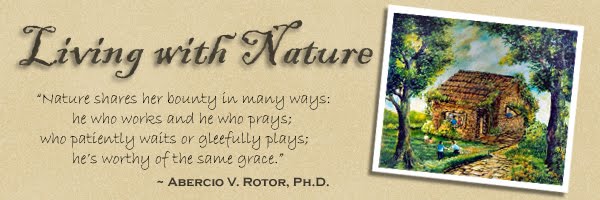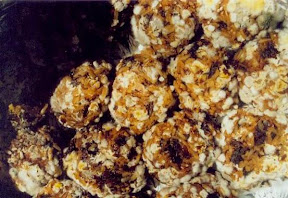UN International Mother Earth Day - April 22, 2022
20 Ecological Concerns to Restore Our Earth's Health and Balance
"In the long history of humankind (and animal kind, too) those who learned to collaborate and improvise most effectively have prevailed." - Charles Darwin
Dr Abe V Rotor
Living with Nature School on Blog
2. What and Where is the so-called Good Life? The Good Life is shifting with the transformation of agricultural to industrial economy.
3. The Good Life is synonymous to Affluence. People want goods and services beyond what they actually need. Want leads to luxury - to waste.
Global warming causes flood, wildfire, species extinction, desertification,
and many other consequences. Acrylic painting by AV Rotor..
4. The world’s population is 7.7 billion. Another billion will be added in less than 10 years. Runaway population is the mother of human miseries
5. The proliferation of cities, growth of cities to metropolises and megapolises, each with 10 to 20 million people ensconced in cramped condition. Cities breed marginal communities
------------------
“People, people everywhere, but not a kindred to keep," in condominiums, malls, schools, churches, parks, sharing common lifestyles and socio-economic conditions. They are predisposed to common health problems and vulnerabilities from brownouts to food and fuel shortage, force majeure notwithstanding.
------------------
6. Loss of Natural Environment – loss of productivity, loss of farmlands, and wildlife. Destruction of ecosystems - lakes, rivers, forests, coral reefs, grasslands, etc. Destruction of ecosystems is irreversible.
7. Species are threatened, many are now extinct, narrowing down the range of biodiversity. Human health depends largely on a complex interrelationship of the living world. No place on earth is safe from human abuse. Coral Reef – bastion of terrestrial and marine life, is now in distress.
8. Wildlife shares with our homes, backyards and farms, transmitting deadly diseases like SARS, HIV-AIDS, Mad-Cow, FMD, Ebola, and Bird Flu which can now infect humans, allergies notwithstanding.
9. “Good Life” cradles and nurses obesity and other overweight conditions. Millions of people around the world are obese, with 34% of Americans in the US obese.
10. Global warming stirs climatic disturbance, changes the face of the earth.
11. Globalization packages the major aspects of human activity – trade, commerce, industry, agriculture, the arts, education, science and technology, politics, religion and the like.
6. Loss of Natural Environment – loss of productivity, loss of farmlands, and wildlife. Destruction of ecosystems - lakes, rivers, forests, coral reefs, grasslands, etc. Destruction of ecosystems is irreversible.
7. Species are threatened, many are now extinct, narrowing down the range of biodiversity. Human health depends largely on a complex interrelationship of the living world. No place on earth is safe from human abuse. Coral Reef – bastion of terrestrial and marine life, is now in distress.
8. Wildlife shares with our homes, backyards and farms, transmitting deadly diseases like SARS, HIV-AIDS, Mad-Cow, FMD, Ebola, and Bird Flu which can now infect humans, allergies notwithstanding.
9. “Good Life” cradles and nurses obesity and other overweight conditions. Millions of people around the world are obese, with 34% of Americans in the US obese.
10. Global warming stirs climatic disturbance, changes the face of the earth.
11. Globalization packages the major aspects of human activity – trade, commerce, industry, agriculture, the arts, education, science and technology, politics, religion and the like.
12. . Mélange of races - pooling of genes through inter-racial and inter-cultural marriages produces various mixed lines or “mestizos” - Eurasian, Afro-Asian, Afro-American, Amerasian, and the like. Native genes provide resistance to diseases, adverse conditions of the environment. But will this advantage hold on even as the native gene pools are thinned out?
13. Modern medicine is responsible in reducing mortality and increasing longevity. It has also preserved genetically linked abnormalities; it cradles senility related ailments. It made possible the exchange of organs and tissues through transplantation, and soon tissue cloning. It has changed Evolution that is supposed to cull out the unfit and misfits. Man has Darwinism in his hands.
14. The first scientific breakthrough is the splitting of the atom that led to the development of the atomic bomb as the most potent tool of war as evidenced by its destruction at Nagasaki and Hiroshima, and the nuclear reactor which still holds the promise of providing incessant energy to mankind. The second scientific breakthrough – Microchip led to the development of the Internet which “shrunk the world into a village.”
16. The third breakthrough in science, Genetic Engineering, changed our concept of life - and life forms. It has enabled man to tinker with life itself. Revolutionary industries Examples: In vitro fertilization, surrogate motherhood, Human Genome Project (HGP or gene mapping), multiple childbirth, post-menopausal childbirth, DNA mapping, etc. Birth of the prototype human robot – pampered, he lives a very dependent life.
17. Genetic Engineering gave rise to Genetically Modified Organisms (GMO) and Gene Therapy. It has also primed Biological Warfare into a more terrifying threat to mankind and the environment. On the other hand Gene Therapy aims at preventing gene-link diseases even before they are expressed; it has actually revolutionized medicine. More and more countries are banning GMO crops and animals through legislative measures and conservation programs, including protection against “biopiracy”
18. Today’s Green Revolution opened up non-conventional frontiers of production – mariculture, desalination, desert farming, swamp reclamation, aerophonics (rooftop farming), hydroponics, urban farming, organic farming, Green Revolution adapts genetic engineering to produce GMOs and Frankenfoods. We may not be aware, but many of us are eating genetically modified food (GMF or Frankenfood) everyday – meat, milk, chicken, corn, potato and soya products, and the like mainly from the US. Many food additives and adjuncts are harmful, from salitre in longganiza to pesticide residue in fruits and vegetables, aspartame in fruit juice to MSG in noodles, formalin in fish to dioxin in plastics, bromate in bread to sulfite in sugar, antibiotic residue in meat to radiation in milk.
13. Modern medicine is responsible in reducing mortality and increasing longevity. It has also preserved genetically linked abnormalities; it cradles senility related ailments. It made possible the exchange of organs and tissues through transplantation, and soon tissue cloning. It has changed Evolution that is supposed to cull out the unfit and misfits. Man has Darwinism in his hands.
14. The first scientific breakthrough is the splitting of the atom that led to the development of the atomic bomb as the most potent tool of war as evidenced by its destruction at Nagasaki and Hiroshima, and the nuclear reactor which still holds the promise of providing incessant energy to mankind. The second scientific breakthrough – Microchip led to the development of the Internet which “shrunk the world into a village.”
16. The third breakthrough in science, Genetic Engineering, changed our concept of life - and life forms. It has enabled man to tinker with life itself. Revolutionary industries Examples: In vitro fertilization, surrogate motherhood, Human Genome Project (HGP or gene mapping), multiple childbirth, post-menopausal childbirth, DNA mapping, etc. Birth of the prototype human robot – pampered, he lives a very dependent life.
17. Genetic Engineering gave rise to Genetically Modified Organisms (GMO) and Gene Therapy. It has also primed Biological Warfare into a more terrifying threat to mankind and the environment. On the other hand Gene Therapy aims at preventing gene-link diseases even before they are expressed; it has actually revolutionized medicine. More and more countries are banning GMO crops and animals through legislative measures and conservation programs, including protection against “biopiracy”
18. Today’s Green Revolution opened up non-conventional frontiers of production – mariculture, desalination, desert farming, swamp reclamation, aerophonics (rooftop farming), hydroponics, urban farming, organic farming, Green Revolution adapts genetic engineering to produce GMOs and Frankenfoods. We may not be aware, but many of us are eating genetically modified food (GMF or Frankenfood) everyday – meat, milk, chicken, corn, potato and soya products, and the like mainly from the US. Many food additives and adjuncts are harmful, from salitre in longganiza to pesticide residue in fruits and vegetables, aspartame in fruit juice to MSG in noodles, formalin in fish to dioxin in plastics, bromate in bread to sulfite in sugar, antibiotic residue in meat to radiation in milk.
Hydroponics or soilless culture makes farming feasible in cramped quarters, and it increases effective area of farming.
Aeroponics or Multi-storey farming Vertical Farming Farming in the city on high rise buildings• Post Harvest Technology. is critical to Food Production. PHT bridges production and consumption, farm and market, thus the proliferation of processed goods, supermarket, fast food chains, food irradiation, ready-to-eat packs, etc.
 19. Exploration into the depth of the sea and expanse of the Solar System - and beyond. We probe the hadal depth of the ocean. We build cities in space - the Skylab. Soon we will live outside of the confines of our planet earth. Now we aim at conquering another planet, another Solar System to assure continuity of mankind after the demise of the earth.
19. Exploration into the depth of the sea and expanse of the Solar System - and beyond. We probe the hadal depth of the ocean. We build cities in space - the Skylab. Soon we will live outside of the confines of our planet earth. Now we aim at conquering another planet, another Solar System to assure continuity of mankind after the demise of the earth.20. Regional and International Cooperation is key to global cooperation: EU, ASEAN, APEC, CGIAR, ICRISAT, WTO, WHO, UNEP, WFO, FAO, like fighting pandemic diseases – HIV-AIDS, SARS, Dengue, Hepatitis, Bird Flu, etc.



































